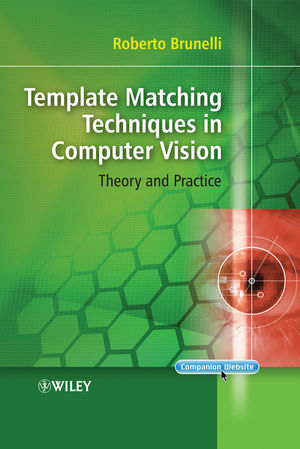Template Matching Techniques in Computer Vision: Theory and PracticeISBN: 978-0-470-51706-2
Hardcover
352 pages
April 2009
 |
||||||
1 Introduction.
1.1 Template Matching and Computer Vision.
1.2 The Book.
1.3 Bibliographical Remarks.
References.
2 The Imaging Process.
2.1 Image Creation.
2.1.1 Light.
2.1.2 Gathering Light.
2.1.3 Diffraction-limited Systems.
2.1.4 Quantum Noise.
2.2 Biological Eyes.
2.2.1 The Human Eye.
2.2.2 Alternative Designs.
2.3 Digital Eyes.
2.4 Digital Image Representations.
2.4.1 TheSampling Theorem.
2.4.2 Image Resampling.
2.4.3 Log-polar Mapping.
2.5 Bibliographical Remarks.
References.
3 Template Matching as Testing.
3.1 Detectionand Estimation.
3.2 Hypothesis Testing.
3.2.1 The Bayes RiskCriterion.
3.2.2 The Neyman–Pearson Criterion.
3.3 An Important Example.
3.4 A Signal Processing Perspective: Matched Filters.
3.5 Pattern Variability and the Normalized Correlation Coefficient.
3.6 Estimation.
3.6.1 Maximum Likelihood Estimation.
3.6.2 Bayes Estimation.
3.6.3 James–Stein Estimation.
3.7 Bibliographical Remarks.
References.
4 Robust Similarity Estimators.
4.1 Robustness Measures.
4.2 M-estimators.
4.3 L1 Similarity Measures.
4.4 Robust Estimation of Covariance Matrices.
4.5 Bibliographical Remarks.
References.
5 Ordinal Matching Measures.
5.1 Ordinal Correlation Measures.
5.1.1 Spearman Rank Correlation.
5.1.2 Kendall Correlation.
5.1.3 Bhat–Nayar Correlation.
5.2 Non-parametric Local Transforms.
5.2.1 The Census and Rank Transforms.
5.2.2 Incremental Sign Correlation.
5.3 Bibliographical Remarks.
References.
6 Matching Variable Patterns.
6.1 Multiclass Synthetic Discriminant Functions.
6.2 Advanced Synthetic Discriminant Functions.
6.3 Non-orthogonal Image Expansion.
6.4 Bibliographical Remarks.
References.
7 Matching Linear Structure: The Hough Transform.
7.1 Getting Shapes: Edge Detection.
7.2 The Radon Transform.
7.3 The Hough Transform: Line and Circle Detection.
7.4 The Generalized Hough Transform.
7.5 Bibliographical Remarks.
References.
8 Low-dimensionality Representations and Matching.
8.1 Principal Components.
8.1.1 Probabilistic PCA.
8.1.2 How Many Components?
8.2 ANonlinear Approach: Kernel PCA.
8.3 Independent Components.
8.4 Linear Discriminant Analysis.
8.4.1 Bayesian Dual Spaces.
8.5 A Sample Application: Photographic-quality Facial Composites.
8.6 Bibliographical Remarks.
References.
9 Deformable Templates.
9.1 A Dynamic Perspective on the Hough Transform.
9.2 Deformable Templates.
9.3 Active Shape Models.
9.4 DiffeomorphicMatching.
9.5 Bibliographical Remarks.
References.
10 Computational Aspects of Template Matching.
10.1 Speed.
10.1.1 Early Jump-out.
10.1.2 TheUse of SumTables.
10.1.3 Hierarchical Template Matching.
10.1.4 Metric Inequalities.
10.1.5 The FFT Advantage.
10.1.6 PCA-basedSpeed-up.
10.1.7 A Combined Approach.
10.2 Precision.
10.2.1 A Perturbative Approach.
10.2.2 Phase Correlation.
10.3 Bibliographical Remarks.
References.
11 Matching Point Sets: The Hausdorff Distance.
11.1 Metric Pattern Spaces.
11.2 Hausdorff Matching.
11.3 Efficient Computation of the Hausdorff Distance.
11.4 Partial Hausdorff Matching.
11.5 Robustness Aspects.
11.6 A Probabilistic Perspective.
11.7 Invariant Moments.
11.8 Bibliographical Remarks.
References.
12 Support Vector Machines and Regularization Networks.
12.1 Learning and Regularization.
12.2 RBF Networks.
12.2.1 RBF Networks for Gender Recognition.
12.3 Support Vector Machines.
12.3.1 Improving Efficiency.
12.3.2 Multiclass SVMs.
12.3.3 Best Practice.
12.4 Bibliographical Remarks.
References.
13 Feature Templates.
13.1 Detecting Templates by Features.
13.2 Parametric FeatureManifolds.
13.3 Multiclass Pattern Rejection.
13.4 Template Features.
13.5 Bibliographical Remarks.
References.
14 Building a Multibiometric System.
14.1 Systems.
14.2 The Electronic Librarian.
14.3 Score Integration.
14.4 Rejection.
14.5 Bibliographical Remarks.
References.
Appendices.
A AnImAl: A Software Environment for Fast Prototyping.
A.1 AnImAl: An Image Algebra.
A.2 Image Representationand Processing Abstractions.
A.3 The AnImAl Environment.
A.4 Bibliographical Remarks.
References.
B Synthetic Oracles for Algorithm Development.
B.1 Computer Graphics.
B.2 Describing Reality: Flexible Rendering Languages.
B.3 Bibliographical Remarks.
References.
C On Evaluation.
C.1 A Note on Performance Evaluation.
C.2 Traininga Classifier.
C.3 Analyzing the Performance of a Classifier.
C.4 Evaluating a Technology.
C.5 Bibliographical Remarks.
References.
Index.



